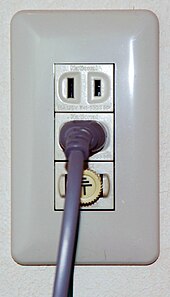Power cord
This article needs additional citations for verification. (September 2010) |

A power cord, line cord, or mains cable is an
A cord set includes connectors molded to the cord at each end (see
Features
Power cables may be either fixed or detachable from the appliance.
A power cord or
In North America, the National Electrical Manufacturers Association develops standards for electrical plugs and receptacles and cables.[2]
International power cords and plug adapters are used in conjunction with electrical appliances in countries different from those in which they were designed to operate. Besides a cord with one end compatible to receptacles or a device from one country and the other end compatible with receptacles or devices from another country, a voltage converter is usually necessary, as well, to protect travelers' electronic devices, such as laptops, from the differing voltages between the United States and places like Europe or Africa.
North American lamp cords have two single-insulated conductors designed for low-current applications. The insulator covering one of the conductors is ribbed (parallel to wire) for the entire length of the cord, while the other conductor's insulator is smooth. The smooth one is hot and the ribbed one is neutral.[3]
Connectors
IEC 60320 power cables come in normal and high-temperature variants, as well as various rated currents. The connectors have slightly different shapes to ensure that it is not possible to substitute a cable with a lower temperature or current rating, but that it is possible to use an overrated cable. Cords also have different types of exterior jackets available to accommodate environmental variables such as moisture, temperature, oils, sunlight, flexibility, and heavy wear. For example, a heating appliance may come with a cord designed to withstand accidental contact with heated surfaces.
Worldwide, more than a dozen different types of AC power plugs and sockets are used for fixed building wiring. Products sold in many different markets can use a standardized IEC 60320 connector and then use a detachable power cord to match the local electrical outlets. This simplifies safety approvals, factory testing, and production since the power cord is a low-cost item available as a commodity. Since the same types of appliance-side connectors are used with both 120 V and 230 V power cables, the user must ensure the connected equipment will operate with the available voltage. Some devices have a slide-switch to adapt to different voltages, or wide-ranging power supplies.
Standards
National electrical codes may apply to power cords and related items. For example, in the United States, power cords must meet UL Standards 62[4] and 817.[5]
Power supplies
Cord sets must be distinguished from AC adapters, where the connector also contains a transformer, and possibly rectifiers, filters and regulators. Unwary substitution of a standard mains-voltage connector for the power supply would result in application of full line voltage to the connected device, resulting in its destruction and possible fire or personal injury.
See also
References
- ISBN 9780070577831.
- ^ NEMA - Flexible Cords Section Archived 2011-11-03 at the Wayback Machine
- ^ Merle Henkenius; Popular Mechanics Dec 1987 How to Repair an Incandescent Lamp:Installing an in-line switch; p.130; [1] (retrieved 3/23/12)
- ^ UL 62 (2010-05-18). "Flexible Cords and Cables". Retrieved 2017-01-25.
{{cite web}}: CS1 maint: numeric names: authors list (link) - ^ UL 817 (2001-03-16). "Standard for Cord Sets and Power-Supply Cords". Retrieved 2017-01-25.
{{cite web}}: CS1 maint: numeric names: authors list (link)
